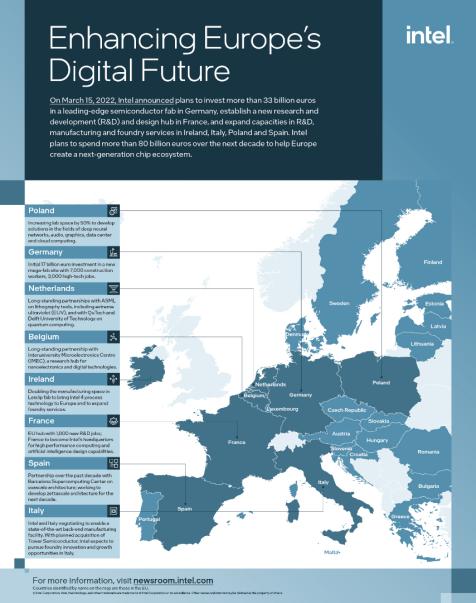Intel Announces "Silicon Junction," an $80 Billion Semiconductor Investment in the EU
EU's share of global semiconductor manufacturing expected to reach 20% by 2030.
Intel today announced aggressive investment plans for the European Union, with the company predicting it will invest no less than 80 billion euros in the continent by the end of the decade. Intel's priority will be to bring a new leading-edge Mega Fab in Magdeburg, Germany online, which will soak an estimated $17 billion from the investment plan. The company also announced plans to deploy a new R&D and design hub in France and additional investments in R&D, manufacturing, and foundry services in Ireland, Italy, Poland, and Spain.
Intel's move aims to increase the EU's stake in the global semiconductor manufacturing field while reducing global supply chain dependencies on Asia and the US. In addition, Intel will take advantage of several governmental and EU subsidies, the EU's equivalent to the United States' Chips Act is worth a cool $43 billion in support for installing semiconductor manufacturing capabilities within the continent's borders, despite complete independence being stated as impossible.
“Our planned investments are a major step both for Intel and for Europe. The EU Chips Act will empower private companies and governments to work together to drastically advance Europe’s position in the semiconductor sector," said Intel CEO Pat Gelsinger. "This broad initiative will boost Europe’s R&D innovation and bring leading-edge manufacturing to the region for the benefit of our customers and partners around the world. We are committed to playing an essential role in shaping Europe’s digital future for decades to come.”


The goal is high - bringing the EU's semicondcutor manufacturing footprint to 20% of the global volume by 2030.
Investments in Semiconductor Facilities
Intel aims to create a new "Silicon Junction" within the EU, specifically in Germany due to that country's tech talent, superb industrial support infrastructure, and existing ecosystem of suppliers and customers. Magdeburg will thus be the new nerve center for Intel's EU operations, with two "first-of-its-kind" fabrication plants beginning construction as early as the first half of next year (planning is already underway). The new fabs are expected to deliver chips using Intel’s leading-edge technologies - including future Angstrom-era transistor technologies, expanding Intel's capabilities to service not only itself, but global silicon customers under its IDM (Integrated Device Manufacturer) 2.0 strategy. The $17 billion investment is expected to create as many as 7,000 (temporary) construction jobs, as well as 3,000 permanent high-tech jobs at Intel and thousands of indirect jobs within supporting industries and infrastructures.
Besides the investment in Magdeburg, Germany, Intel will also double down on its Leixlip, Ireland fabrication facilities. A $12 billion check will take care of expanding that facilities' footprint and modernizing its fabrication processes, opening up the door to Intel 4 (previously Intel 7nm) manufacturing to occur locally in Europe as well.
Italy should be on the receiving end of a $4.5 billion investment in a state-of-the-art back-end manufacturing facility which Intel says would be the first of its kind in Europe. The facility is expected to be brought online within the 2025-2027 timeframe. Intel also expects to leverage its recent, $6 billion Tower Semiconductor acquisition (still pending completion) and that company's relationship with ST Microelectronics, which currently operates a semiconductor facility in Italy's Agrate Brianza region for semiconductor-bound partnerships. Intel expects the new Italian facility alone to generate around 1,500 Intel jobs plus an additional 3,500 indirect jobs.

Strengthening European Semiconductor R&D
Besides direct semiconductor manufacturing plans, Intel will strengthen its research and development facilities on European soil, taking advantage of a likely underutilized high-tech knowledge base. Intel will deploy a new European R&D hub in Plateau de Saclay, France, which will become Intel's headquarters for high performance computing (HPC) and artificial intelligence (AI) design capabilities. This makes sense considering the EU's burgeoning automotive, energy, genomics, life sciences, and security capabilities.
The new Intel R&D hub should eventually allow for the creation of 1,000 new high-tech job, 450 of which should be available by the end of 2024. Besides the HPC and AI research hub, Intel will also set up its premier European semiconductor design center in France, which will provide Intel customers with design solutions within its IDM 2.0 strategy. Once again, Intel's investment is a boon for local economies: the company expects its France investments to result in 1,000 new high-tech jobs at Intel, with 450 jobs available by the end of 2024 already. A relatively less capital-intensive investment will see Intel expanding its AI, audio, graphics, data center and cloud computing R&D center in Gdansk, Poland by around 50% of its current footprint. Details are scarce on this investment, but the company expects work to be complete by the end of 2023.
Get Tom's Hardware's best news and in-depth reviews, straight to your inbox.
Besides investments in new facilities and strengthening of the existing infrastructure, Intel is also launching multiple partnerships with European companies, universities, and research centers. The company will double down on existing R&D arrangements with IMEC (Belgium), the Technical University of Delft (Netherlands), CEA-Leti (France), and the Fraunhofer Institutes (Germany). Intel is also developing new partnerships in Italy with Leonardo, INFN, and CINECA with the aim to explore advanced new solutions in HPC, memory, software programming models, security and cloud. A deepened collaboration with the Barcelona Supercomputing Center (Spain) will pursue the development of a zettascale supercomputing architecture within the next decade, building upon years of expertise in designing exascale architectures.


An intel-provided infographic with the fundamental investment points from its EU expansion plans.
Closing Thoughts
Intel's investment announcement comes smack in the middle of the Russian-Ukraine conflict, which has seen energy prices skyrocket across the EU. Despite the currently tense prospects of the conflict and its potential long-lasting impact on global semiconductor supply chains, Intel knows that it's in its best interests to decentralize its manufacturing operations while taking advantage of the EU's strong internal infrastructure and R&D capabilities. In the current climate, Intel's goal to have all of its European facilities powered by renewable energies becomes one of strategic importance not only for the company but also for the EU. That, of course, is in addition to the environmental benefits.
Naturally, the $43 billion EU Chips Act package must have helped Intel's investment decision, and no small part of it will be heading Intel's way — beyond any incentives the company receives at a national level. Despite the uncertainty and the measurably higher costs with personnel and infrastructure, the EU and its member countries are the natural choice for Intel's manufacturing and R&D decentralization.
It would be remiss of the company to delay or cancel these plans, which take years to formulate, on account of the Russian-Ukrainian war happening right at the EU's doorstep. That the company elected to maintain them shows confidence in the EU's (and the rest of the international community) capability to resolve the conflict without a full-scale war blossoming on the continent. One can hope.

Francisco Pires is a freelance news writer for Tom's Hardware with a soft side for quantum computing.